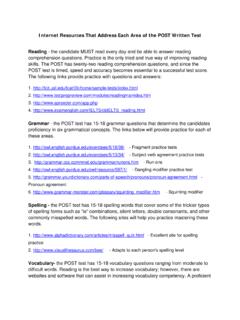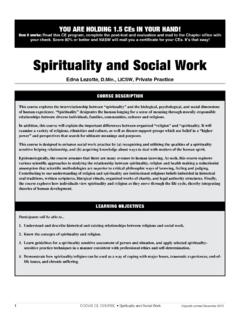Transcription of Description of mechanical properties - ArcelorMittal
1 ArcelorMittal Europe Flat Products Description of mechanical properties Introduction mechanical properties are governed by the basic concepts of elasticity, plasticity and toughness. Elasticity is the capacity of a metal to undergo temporary deformation. As soon as the load that caused this deformation is removed, the metal returns to its original shape. Plasticity, or ductility, is the ability to undergo permanent deformation without failure. This property is used in metal forming in order to permanently modify the shape.
2 Toughness represents the ability to absorb shocks without suddenly failing, and can be regarded as the opposite of brittleness. The aim of mechanical testing is to evaluate the behaviour of a material when subjected to a mechanical load. Elasticity and plasticity can be defined from tensile test results and hardness measurements. Toughness is determined by an impact bending test. Tensile tests Testing procedure This test involves subjecting a metal specimen to a slow, gradually increasing tensile load, in order to allow equilibrium to be constantly established between the imposed load and the induced strain.
3 The test-piece usually comprises two reference marks, initially spaced at a distance L0, known as the initial gauge length. When a force F is applied to the specimen, the deformation causes the gauge length to increase to a value L. Modern testing machines constantly record the gauge length as a function of the applied load and directly plot a curve representing the variation of the strain L - L0 with stress (load per unit area) F . L0. S0. The following curve gives an example of the type of diagram obtained and illustrates the deformation of the specimen during the test.
4 >. 1. Description of mechanical properties Standard mechanical properties R= F. Re = yield stress, yield strength or yield point, S0. B. in MPa or N/mm2, corresponding to the end Rm C. of the elastic region (point A in the diagram). Rm = ultimate tensile strength, in MPa or N/mm2 (point B in the diagram) A. Re Necking A% = total elongation at failure, in % Uniform elongation elongation L - L0. (point C in the diagram, specimen 4) A% = x 100. L0. The Description of the test and the values 0. to be measured are given in the standard EN ISO 6892-1:2009.
5 S0 S. L0 L Lu Su S0 = Initial gauge length area S = Area during test Su = Final area in neck Lu = Final length Three particular points can be seen on this curve, and are marked A, B and C. Between the origin 0 and A, the specimen's elongation is proportional to the stress. If the stress is removed, the elongation returns to 0. The line segment 0A thus corresponds to the elastic region (specimen 1). Between A and B, the deformation is spread out in a uniform way over the test-piece (specimen 2). If the stress is released, the sample no longer returns to its initial length.
6 This is the plastic region. Since the deformation is homogeneous over the whole of the specimen, this range is called the uniform elongation region. Between B and C (specimen 3), the deformation becomes localised ( necking ), leading to failure at point C. 2. Description of mechanical properties Hardness tests Principle In this test, an indenter is forced into the metal to be characterised. The applied load is constant, so that the softer the tested material, the larger the size of the permanent indentation (projected area, depth).
7 Description of the tests In general, two types of indenter are used, either a ball or a point. These two geometries form the basis of the two major test categories, within which the size of the indenter and the applied load can vary. Ball indenter: Rockwell (scales B, E and K), surface Rockwell (scale T), Brinell tests Point indenter: Vickers, Rockwell (scales A, C and D), surface Rockwell (scale N) tests Rockwell test In the HRB test, which is one of the most commonly used, a 1/16'' diameter ball is pressed into the sheet under a load F1 of 100 kgf, after having applied a preload F0, and the depth of the indentation is measured (see the following figures).
8 The HRB scale is limited to values of 100 HRB. Beyond this level, the HRC method is used, based on the same principle, but with a conical diamond indenter and an applied load F1 of 150 kgf. F0 F0 + F1 F0 F0 F0 + F1 F0. Cone .. Sample Sample e=c-a e=c-a surface surface c a b a b c 130 100. HARDN SS. HARDN SS.. mm mm .. 0 0. HRB = 130 - e HRC = 100 - e >. 3. Description of mechanical properties Vickers test The end of the indenter is diamond-shaped in the form of a square-based pyramid. The load applied can vary from 5 to 100 kgf.
9 The resulting hardness is calculated from the ratio of the applied load to the area of the indentation. In practice, the average of the two diagonals of the impression is determined, the hardness value being read directly from a conversion table (see the figure below). F. d1. 136 . d2. HV = F/d2. Penetrator apex angle = 136 . F = test load in Newtons 1%. d = diagonal of imprint in mm = (d1 + d2)/2. Values measured Depending on the test, either the depth or the size of the indentation is measured. This value is compared to tables, which give a unitless number, as a function of the applied load, characterising the hardness of the metal.
10 Remarks There is no reliable correlation between the hardness and the mechanical properties determined in a tensile test. This is due to the principle of the hardness measurements, which evaluates only the surface properties of the material, whereas the tensile test characterises the entire volume. 4. Description of mechanical properties Impact strength Testing procedure The test consists in measuring the energy required to break a V- or U-notched specimen, supported at two points, in a single blow. The impact strength is the energy, expressed in joules per cm2, necessary to break the notched specimen.









